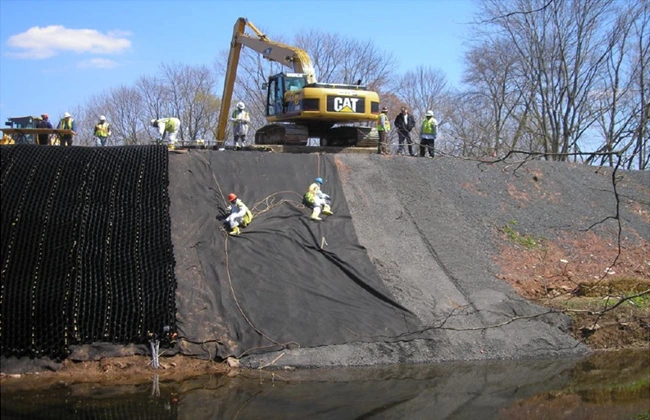Key takeaways: The BoRit Asbestos site is an area of concentrated asbestos waste, located in the suburbs
of Philadelphia. It was unregulated until 2009, when the Environmental Protection Agency
(EPA) put it on a National Priority List. The actions taken to protect members of the Ambler (and
surrounding) community include topping the asbestos with soil and vegetation and regular
check-ins of the site.

Preparing for geotextile insertion. Taken from https://www.epa.gov/ambler/borit-asbestos-superfund-site-photos
History of the Site
Ambler, Pennsylvania is located approximately 20 miles north of Center City, Philadelphia.
A nearby asbestos production plant–which was active from the early to mid 20th century–used a
32 acre site located next within Ambler. They dumped asbestos, asbestos products, and
by-products of asbestos production within the parameters of the site. The site contained a pile of
waste and by-products, a reservoir (whose walls were constructed with soil and asbestos
shingles), and an abandoned playground/park area. When production of asbestos slowed due to
more stringent government regulations, the site was abandoned; however, there were no
measures taken to mitigate asbestos exposure for the residents of Ambler. Because of both the
amount of asbestos (and consequent risk of it becoming airborne) and its proximity to three local
creeks, local residents were justifiably concerned about the site.
EPA Intervention
In 2009, the BoRit Ambler site was deemed a candidate for the “National Priority List,” meaning
that the government funneled action, attention, and extra money to the area. The EPA deliberated
about a solution: it needed to be as cost effective as possible while adequately protecting local
residents. The EPA decided to cover the asbestos with “geotextile,” or a combination of soil,
vegetation, and topsoil. The minimum density of this layer of geotextile was to be no less than
two feet. In addition to geotextile capping, there were efforts to revitalize and stabilize the local
streams that were previously contaminated by the BoRit site.
The rationale for the geotextile cover was the sheer amount of asbestos and waste in the area: it
would be more difficult to remove or repurpose. Other options included removing the waste
entirely or melting it down and reshaping it (to be smaller/fit closer together). These options
were deemed either too expensive or too extreme.
Future Outlook
As a part of the EPA intervention, the agency also requires regular check-ins and maintenance.
There are mandated quarterly check-ins to ensure the standing of the site. (Is there a minimum of
two feet of geotextile? Are the banks of the creek still stable? Is the vegetation still stable?) In
addition to quarterly check-ins, the EPA requires check-ins after extreme weather events to
ensure that the site is still stable and that the asbestos is still covered. Lastly, there are five-year
reviews in place to ensure the feasible longevity of the site. Besides the more “mechanical”
check-ins of soil and vegetation integrity, these five-year reviews take a more micro approach.
Scientists collect air, water, sediment, and soil samples to ensure the EPA’s measures are keeping
the community healthy and safe.
If you or a loved one has been diagnosed with an asbestos-related disease, please call
(800)-505-6000 for legal help. For more information, fill out the form on our Homepage.
Source:
BORIT ASBESTOS Site Profile. (n.d.). Retrieved January 29, 2024, from
https://cumulis.epa.gov/supercpad/SiteProfiles/index.cfm?fuseaction=second.cleanup&i
d=0301842#Status